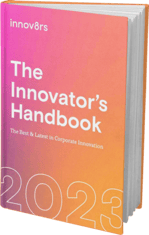Our monthly innovation updates provide you with an overview of the most relevant insights, best practices & tools from the innovation cosmos.
1. Innovating in uncertain times: lessons from 2022
Due to fear of missing out (FOMO), many leaders rush to adopt new technologies without proper planning, leading to wasted investments and missed opportunities. Managers should exercise patience and carefully evaluate new technologies before committing to them.
Responsible exploration is key to successfully navigating the constantly changing technology landscape. An article from Harvard Business Review highlights five lessons the tech world learned last year and provides takeaways to drive growth through transformation in the face of uncertainty.
1. Economic uncertainty demands strategic digital investment
Despite conventional wisdom to cut costs during a downturn, technology spending is forecast to grow more than 5% in 2023. Businesses should invest in technology solutions that drive efficiency, reshape revenue streams, and create new value propositions to emerge stronger and more innovative from economic disruption.
2. Labor market volatility inhibits innovation
High employee turnover and increasing salary demands in the technology industry inhibit innovation. Managers should focus on building a strong culture and creating an environment that supports employee engagement and development instead of hiring "unicorns" who are likely to leave soon. The best way to retain top talent is to prioritize factors such as competitive pay, the ability to contribute to meaningful work, and job flexibility.
3. Sustainability must be a top tech priority
IT has a significant impact on the carbon footprint and energy consumption of organizations. The application of technologies like Cloud and Artificial Intelligence can identify sustainable business opportunities and drive enterprise sustainability efforts. According to a recent survey, 87% of business leaders expect to increase investment in sustainability in the next two years and see it as a way to protect their organization from disruption and reduce costs. Managers should lead the charge by championing technology-led sustainability solutions within their teams.
4. Cybersecurity becomes increasingly complex in a fast-moving business environment
Cybersecurity has become a top business priority but the rapid pace of business and digitalization make it increasingly complex. Organizations should prioritize spending on cyber security that protects business outcomes rather than trying to protect against every threat. Security readiness is impacted by business decisions, and all managers should understand and accept the responsibility that security is a consequence of decisions they make for their teams and the business every day.
5. Responsible investment in emerging technologies will pay dividends
Emerging technologies such as metaverse, Web3, NFTs, and generative AI have massive potential implications for business disruption but are still in the early stages of development. Despite market failures and hype, these technologies continue to move forward, and responsible investment in these emerging technologies will pay dividends in the long run. Companies have found success with metaverse-adjacent technologies like platforms for immersive streaming, VR headsets, and haptic gloves by focusing on targeted use cases.
2. How to keep track of your innovation projects throughout the year
Continuously steering and monitoring innovation projects within the organization is important for several reasons. Since the business environment is constantly changing, new opportunities and threats can arise at any time. Companies need to be able to quickly adapt and pivot their innovation efforts according to these changes. Additionally, innovation projects can be complex and multifaceted, involving multiple teams and stakeholders, and require ongoing communication, coordination, and alignment to ensure that they are progressing as planned and delivering the desired results. Monitoring also helps to identify and mitigate risks. It allows companies to stay agile and responsive to the market while also ensuring that they are effectively using their resources.
Kanban boards are a popular method for managing projects because they provide a clear visual representation of the work that needs to be done. This makes it easier for teams to understand the status of different tasks and collaborate effectively. They also allow you to track the progress of projects and identify bottlenecks or areas that need improvement.
There are a few strategies that can help you to keep track of innovation projects using portfolio Kanban boards:
1. Define goals and objectives to give the project a clear path and keep it on track. With Kanban boards, innovation teams can get a quick overview of their projects or portfolios. You can zoom into certain columns, swimlanes, or projects on Kanban boards to view the task status in more detail or zoom out to get a holistic view of the project and portfolio status. This can help you to identify gaps and opportunities in your overall project portfolio and to view details of critical projects in order to define your goals.
2. Establish a project plan to outline the tasks and ideas that need to be completed in order to achieve the project's goals. Clearly displaying the status of each project in a Kanban board allows you to spot bottlenecks, delays, or other issues that require action. Additionally, Kanban boards can be used to prioritize tasks and resources, which can help mitigate risks by ensuring that critical projects are given priority.
3. Communicating the status of projects regularly with the project team, stakeholders, and other relevant parties to ensure that everyone is on the same page and to improve strategic decision-making. Kanban boards also help to seamlessly connect different programs and the portfolio’s goals.
4. Regularly monitoring the progress allows you to identify any bottlenecks or roadblocks that may arise and address them before they become major problems. Kanban boards help innovation teams to track the development of their projects over time.
Learn more: How to Steer and Monitor Innovation Projects with Portfolio Kanban Boards
3. Our trend of the month: New Talent Strategies
In 2022, the Great Resignation gave way to the Great Reshuffle as millions of people left their jobs in search of more fulfilling and flexible roles. The term quiet quitting began trending on TikTok. And as mass layoffs continue throughout the tech industry—with an average of 1,600 tech workers laid off daily since the start of 2023 (according to data from Layoffs.fyi)—career cushioning is the newest HR buzzword.
Behind the buzzwords, it is clear that the nature, levers, and drivers influencing work and the workplace are changing. The adoption of digital technologies and, most topically, generative AI is transforming how we work. People continue to demand remote and hybrid work. And, despite the many highly-publicized layoffs and tech talent flooding the market at the moment, competition to find the right talent and mix of specialized skills remain a challenge for many companies.
Organizations are competing for the future skills they need to meet growing demands for digitalization, automation, and sustainability and secure long-term growth potential. This is where New Talent Strategies come in. Innovative strategies are needed for buying, building, and retaining talent, as well as augmenting skills using artificial intelligence. The ability to fill gaps quickly and competently represents a strategic advantage for organizations navigating changing and uncertain economic and social conditions.
Changing employee expectations mean that organizations must focus on differentiating their workplace and benefits to attract and retain key talent. Employee benefits packages should reflect the changing needs of the incoming workforce, primarily comprising Generation Z, who report work-life balance and personal well-being as higher priorities than previous generations.
On the current trajectory, it is estimated there could be a skills gap of more than 85 million people by 2030, resulting in USD 8.5 trillion of lost revenue, according to a report from consulting firm Korn Ferry.
Mitigating this situation will likely see HR leaders combine different talent strategies that enable their organizations to pivot quickly and fill gaps as and where they arise. Strategies include partnering with academic institutions to create training programs, networking with local resources to uncover underused talent pools, and revising recruitment approaches to give opportunities to qualified candidates who can often be overlooked based on age, criminal history, disabilities, and immigration status. These new strategies will be crucial as a new generation of workers, an estimated 1.3 billion youth, enter the global workforce.
Open the Future of Work Trend Radar to view additional insights related to New Talent Strategies and other trends driving the future evolution of work, workers, and the workplace.
4. Fact of the month: Gartner top 10 strategic predictions for 2023 and beyond
Is your organization ready to turn uncertainty into opportunity? The Gartner predictions for 2023 for some of the most critical areas of technology and business evolution help you (re)imagine what your organization might need to prepare for.
Build these strategic planning assumptions into your roadmap for the years ahead to capture the interest of strategic thinkers and fuel the excitement of tactical decision-makers.
5. Your monthly dose of innovation
If you’re looking for inspiration and best practices from other experts in corporate innovation, get the new Innov8rs Handbook, which outlines the “what” and “how” for innovation management in 2023. If you have innovation in your title, Innov8rs is a great community of peers to learn from and collaborate with.
2. Meet us at DTIM 2023 in Berlin!
From 5 - 7 March 2023, the largest German-speaking industry event takes place—and ITONICS will be there! The DTIM - Disruptive Technologies & Innovation Foresight Minds is the leading event for innovation, technology, product, and R&D managers.
Good news: You can use our exclusive discount code PARTNER@DTIM23 and save 25% on the standard price!







